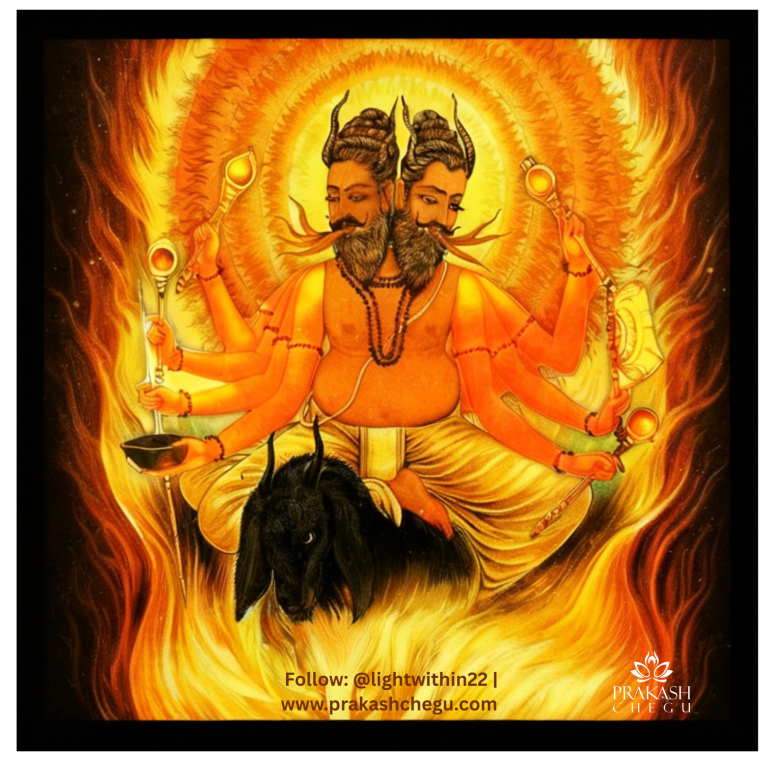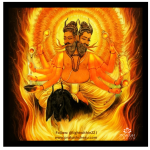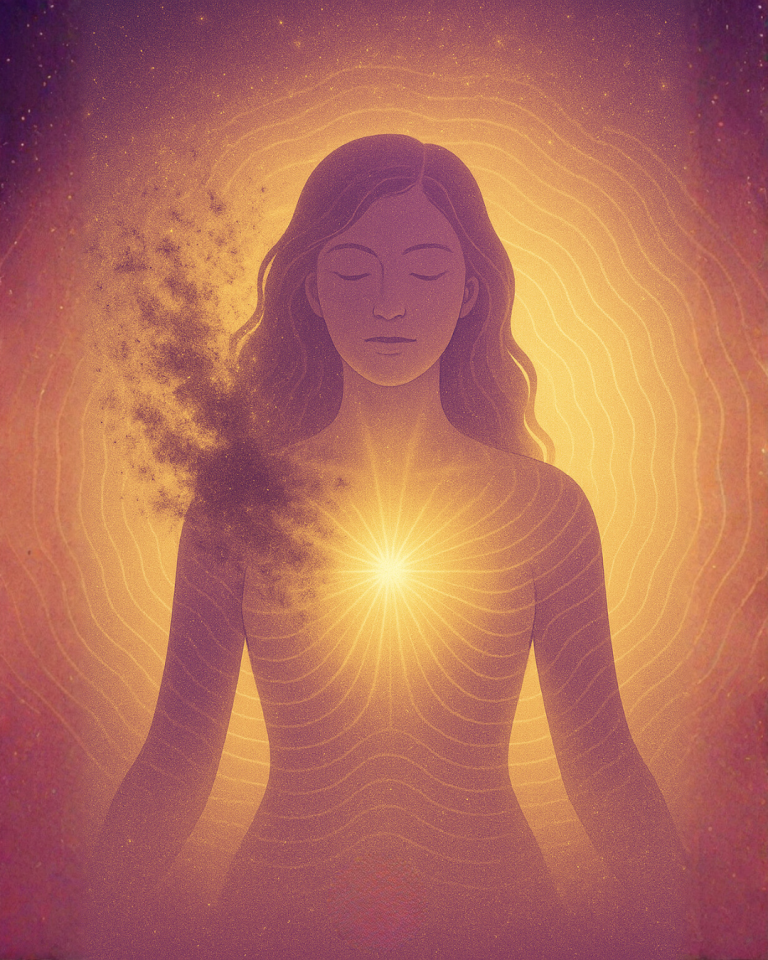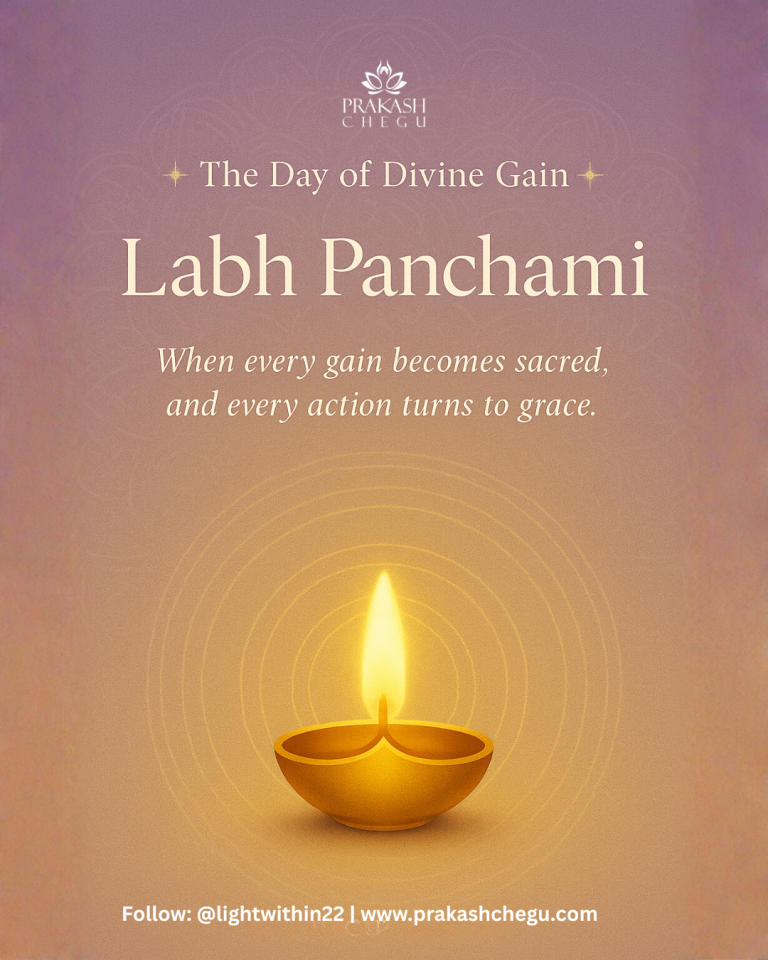Fire: The Sacred Gateway Between Earth and Heaven
Fire is more than heat and light—it is the living bridge between human and divine. In the Vedic vision, Agni is the first to be invoked and the last to depart, the purifier who transforms offerings into blessings, and the messenger who carries prayers upward while drawing grace down into our lives. To honor Agni is to honor transformation itself.
Agni’s Three Realms (and the Three Within)
Vedic seers perceived Agni in a cosmic trinity:
-
On Earth: the hearth and sacrificial flame.
-
In the Mid-Sky: lightning—sudden, illuminating power.
-
In the Heavens: the sun—life-governing radiance.
Within us, Agni burns as vāk (speech/truth), prāṇa (vital force), and buddhi (clarity/intelligence). When these three shine, our actions, energy, and insight align.
The Seven Tongues of Agni — A Map of Inner Alchemy
The Upanishadic image of Agni’s seven tongues is not mere poetry; it’s a spiritual roadmap from density to luminosity:
-
Kali (Black) — burns away impurities and old patterns.
-
Karali (Terrific) — fierce power to break resistance.
-
Manojavā (Mind-Swift) — quickening insight and clear thought.
-
Sulohitā (Deep Red) — vital passion that fuels growth.
-
Śuddhumrāvarṇā (Bright-Smoke) — subtle, mystical perception.
-
Sphuliṅginī (Scintillating) — sparks of illumination and genius.
-
Viśvarucī (All-Gleaming) — universal radiance; the One Light in all.
Contemplation practice: Sit with a candle. As the flame shifts, softly name each tongue and ask, “Which fire is needed in me today?” Journal one line for each.
Two Faces of Fire — Kind and Fierce
Agni’s iconography shows two faces: one benevolent, one formidable. The same fire that cooks and gives warmth can also clear a forest. Spiritually, Agni purifies, but he also demands: truth over pretense, courage over comfort. This is the alchemy by which the old is offered, the essential remains, and new life is born.
Many Names, One Presence
Sanskrit celebrates fire’s facets with many names:
-
Agni — “the forward-moving one,” dynamic transformation.
-
Vahni — the fire that travels with the wind (breath).
-
Hutāśana — the “eater of oblations,” who receives our offerings.
-
Pāvaka — the purifier.
-
Jātavedas — the knower of all, the wisdom latent in light.
-
Vaiśvānara — the fire common to all beings (the universal digestive fire).
Agni in Yoga & Ayurveda
In yogic anatomy, Agni concentrates at Maṇipūra (navel), igniting will, digestion, and luminous clarity. In Ayurveda, jatharagni transforms food into life; when strong, we digest not only meals but also experience. When dull, we accumulate āma (toxicity) in body and mind. Cultivating Agni means cultivating discernment, vitality, and brilliance.
The Sacred Witness of Life
From birth rites and initiations to the Saptapadī of marriage and the final cremation rites, Agni witnesses each passage. The message is constant: what we offer consciously becomes blessing; what we cling to unconsciously becomes smoke.
The Ram — Vehicle of Courage
Agni’s vahana (vehicle) is the ram: bold, initiating, a spark at the start of any true beginning. It invites us to meet life with presence, strength, and forward motion.
Living With Fire — Practice & Ritual
1) The Daily Lamp (Dīpa-Sādhana: 3–7 minutes)
-
When: Sunrise or sunset.
-
How: Place a ghee lamp or candle on a clean surface. Sit tall, breathe gently.
-
Offer: A pinch of flowers or a silent intention.
-
Focus: Watch the flame without strain; let thoughts pass like smoke.
-
Close: Bring palms to the heart; whisper a mantra (see below).
Why it works: You are training attention (air) to steady the flame (fire). Steady attention is steady Agni.
2) The Inner Fire Breath (Mild Agni-Kriyā: 2 minutes)
-
Sit comfortably. Inhale naturally; exhale short, active puffs through the nose (like gently fogging a mirror), belly moving back. Keep the chest relaxed.
-
Do 20–40 light pulses, rest, and repeat for up to 3 rounds.
-
Avoid during pregnancy, high blood pressure spikes, or menstruation if sensitive.
Intention: “May my inner fire burn bright and kind.”
3) A Simple Home Homa (5–10 minutes, weekly)
-
Safe setup: Heat-proof bowl or small homa kund, sand/salt base, nearby water.
-
Fuel: A small charcoal or camphor tablet; a few grains of rice or sesame; a drop of ghee.
-
Steps:
-
Light the fire, sit in humility.
-
Mantra: Recite a short Agni mantra (below).
-
With each “Svāhā,” offer a few grains.
-
Sit in silence; visualize the smoke lifting your prayer.
-
-
Close: Thank Agni; ensure complete extinguishing.
4) Nourish Agni in the Kitchen
-
Favor warm, freshly cooked foods; temper spices in ghee (cumin, ginger, black pepper).
-
Sip hot water or ginger-tulsi tea.
-
Create a no-screens meal space—offer your first bite inward: “To the fire that sustains life.”
Mantra Kit to Honor Agni Deva
1) Seed Mantra (Japa / daily):
ॐ अग्नये नमः — Om Agnaye Namaha
Meaning: I bow to Agni, the purifier and divine messenger.
Use: 108 repetitions, or 3–11 as a mindful pause.
2) Vedic Opening (Rig Veda 1.1.1 — short invocation):
अग्निमीळे पुरोहितं — Agnim īḷe purohitam
Meaning: I adore Agni, the household priest and divine mediator.
Use: Before lighting a lamp, homa, or beginning study/teaching.
3) Universal Fire (for inner strength & clarity):
ॐ जाटवेदसे नमः — Om Jātavedase Namaha
Meaning: Salutations to the all-knowing Fire that carries offerings to light.
Use: When seeking insight, courage, or clean transformation.
4) Offering Mantra (to seal each oblation):
स्वाहा — Svāhā
Meaning: “May this be well-offered.” The sacred release that completes a prayer.
Use: Add softly after an intention, breath cycle, or grain offering.
5) Seven-Tongue Contemplation (name-calling practice):
Kali, Karali, Manojavā, Sulohitā, Śuddhumrāvarṇā, Sphuliṅginī, Viśvarucī… Svāhā.
Use: One slow breath per name; feel the progression from clearing → radiance.
Reflection Prompts (for your journal)
-
What in me is ready to be offered to the fire—today?
-
Where do I need Karali’s courage? Where do I need Pāvaka’s gentleness?
-
How will I keep my word (satya) so that my inner flame remains steady?
Closing: Become the Lamp
Agni is ever-young because every moment is a new spark. When you light a lamp, you are not performing a quaint custom; you are entering a covenant with transformation. Offer what is heavy, receive what is luminous, and let your life become a lamp others can light their lamps from.
Agnim īḷe—today and every day.







